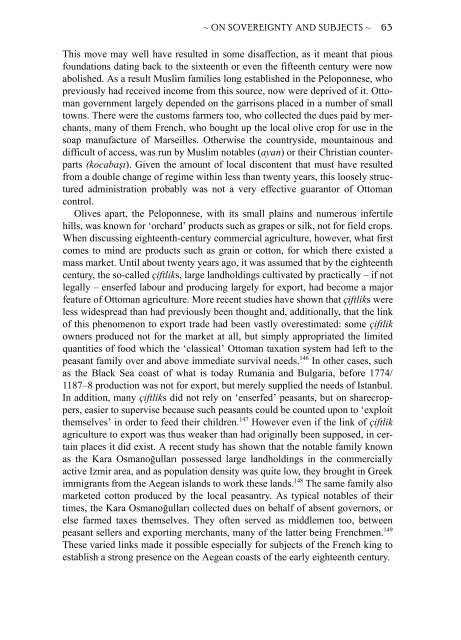The Ottoman Empire and the World Around It - Course Information
The Ottoman Empire and the World Around It - Course Information
The Ottoman Empire and the World Around It - Course Information
Create successful ePaper yourself
Turn your PDF publications into a flip-book with our unique Google optimized e-Paper software.
~ ON SOVEREIGNTY AND SUBJECTS ~ 63<br />
This move may well have resulted in some disaffection, as it meant that pious<br />
foundations dating back to <strong>the</strong> sixteenth or even <strong>the</strong> fifteenth century were now<br />
abolished. As a result Muslim families long established in <strong>the</strong> Peloponnese, who<br />
previously had received income from this source, now were deprived of it. <strong>Ottoman</strong><br />
government largely depended on <strong>the</strong> garrisons placed in a number of small<br />
towns. <strong>The</strong>re were <strong>the</strong> customs farmers too, who collected <strong>the</strong> dues paid by merchants,<br />
many of <strong>the</strong>m French, who bought up <strong>the</strong> local olive crop for use in <strong>the</strong><br />
soap manufacture of Marseilles. O<strong>the</strong>rwise <strong>the</strong> countryside, mountainous <strong>and</strong><br />
difficult of access, was run by Muslim notables (ayan) or <strong>the</strong>ir Christian counterparts<br />
(kocabaşı). Given <strong>the</strong> amount of local discontent that must have resulted<br />
from a double change of regime within less than twenty years, this loosely structured<br />
administration probably was not a very effective guarantor of <strong>Ottoman</strong><br />
control.<br />
Olives apart, <strong>the</strong> Peloponnese, with its small plains <strong>and</strong> numerous infertile<br />
hills, was known for ‘orchard’ products such as grapes or silk, not for field crops.<br />
When discussing eighteenth-century commercial agriculture, however, what first<br />
comes to mind are products such as grain or cotton, for which <strong>the</strong>re existed a<br />
mass market. Until about twenty years ago, it was assumed that by <strong>the</strong> eighteenth<br />
century, <strong>the</strong> so-called çiftliks, large l<strong>and</strong>holdings cultivated by practically – if not<br />
legally – enserfed labour <strong>and</strong> producing largely for export, had become a major<br />
feature of <strong>Ottoman</strong> agriculture. More recent studies have shown that çiftliks were<br />
less widespread than had previously been thought <strong>and</strong>, additionally, that <strong>the</strong> link<br />
of this phenomenon to export trade had been vastly overestimated: some çiftlik<br />
owners produced not for <strong>the</strong> market at all, but simply appropriated <strong>the</strong> limited<br />
quantities of food which <strong>the</strong> ‘classical’ <strong>Ottoman</strong> taxation system had left to <strong>the</strong><br />
peasant family over <strong>and</strong> above immediate survival needs. 146 In o<strong>the</strong>r cases, such<br />
as <strong>the</strong> Black Sea coast of what is today Rumania <strong>and</strong> Bulgaria, before 1774/<br />
1187–8 production was not for export, but merely supplied <strong>the</strong> needs of Istanbul.<br />
In addition, many çiftliks did not rely on ‘enserfed’ peasants, but on sharecroppers,<br />
easier to supervise because such peasants could be counted upon to ‘exploit<br />
<strong>the</strong>mselves’ in order to feed <strong>the</strong>ir children. 147 However even if <strong>the</strong> link of çiftlik<br />
agriculture to export was thus weaker than had originally been supposed, in certain<br />
places it did exist. A recent study has shown that <strong>the</strong> notable family known<br />
as <strong>the</strong> Kara Osmanoğulları possessed large l<strong>and</strong>holdings in <strong>the</strong> commercially<br />
active Izmir area, <strong>and</strong> as population density was quite low, <strong>the</strong>y brought in Greek<br />
immigrants from <strong>the</strong> Aegean isl<strong>and</strong>s to work <strong>the</strong>se l<strong>and</strong>s. 148 <strong>The</strong> same family also<br />
marketed cotton produced by <strong>the</strong> local peasantry. As typical notables of <strong>the</strong>ir<br />
times, <strong>the</strong> Kara Osmanoğulları collected dues on behalf of absent governors, or<br />
else farmed taxes <strong>the</strong>mselves. <strong>The</strong>y often served as middlemen too, between<br />
peasant sellers <strong>and</strong> exporting merchants, many of <strong>the</strong> latter being Frenchmen. 149<br />
<strong>The</strong>se varied links made it possible especially for subjects of <strong>the</strong> French king to<br />
establish a strong presence on <strong>the</strong> Aegean coasts of <strong>the</strong> early eighteenth century.


